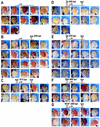Identification of a class of chromatin boundary elements
- PMID: 9819433
- PMCID: PMC109328
- DOI: 10.1128/MCB.18.12.7478
Identification of a class of chromatin boundary elements
Abstract
Boundary elements are thought to define the ends of functionally independent domains of genetic activity. An assay for boundary activity based on this concept measures the ability to insulate a bracketed, chromosomally integrated reporter gene from position effects. Despite their presumed importance, the few examples identified to date apparently do not share sequence motifs or DNA binding proteins. The Drosophila protein BEAF binds the scs' boundary element of the 87A7 hsp70 locus and roughly half of polytene chromosome interband loci. To see if these sites represent a class of boundary elements that have BEAF in common, we have isolated and studied several genomic BEAF binding sites as candidate boundary elements (cBEs). BEAF binds with high affinity to clustered, variably arranged CGATA motifs present in these cBEs. No other sequence homologies were found. Two cBEs were tested and found to confer position-independent expression on a mini-white reporter gene in transgenic flies. Furthermore, point mutations in CGATA motifs that eliminate binding by BEAF also eliminate the ability to confer position-independent expression. Taken together, these findings suggest that clustered CGATA motifs are a hallmark of a BEAF-utilizing class of boundary elements found at many loci. This is the first example of a class of boundary elements that share a sequence motif and a binding protein.
Figures






References
-
- Cai H, Levine M. Modulation of enhancer-promoter interactions by insulators in the Drosophila embryo. Nature. 1995;376:533–536. - PubMed
-
- Chung J H, Whiteley M, Felsenfeld G. A 5′ element of the chicken β-globin domain serves as an insulator in human erythroid cells and protects against position effect in Drosophila. Cell. 1993;74:505–514. - PubMed
-
- Cuvier, O., and U. K. Laemmli. Unpublished data.
Publication types
MeSH terms
Substances
LinkOut - more resources
Full Text Sources
Other Literature Sources
Molecular Biology Databases
